Solar energy storage systems are mainly composed of the following components, each of which plays an important role:
Solar panels: This is the core component of the system, converting sunlight into direct current. Imagine that they are like small solar power plants that collect the sun's energy.
Controller: The controller is like the "brain" of the system, which is responsible for managing the operation of the entire system. It controls the charging and discharging of the battery according to the intensity of sunlight and the power of the battery to ensure that the system works efficiently and stably.
Battery: The battery is the "energy warehouse" of the system, which stores the electricity generated by the solar panels for use at night or on cloudy days.
Inverter: The inverter converts direct current into alternating current used in our daily lives, so that we can use solar energy to drive various electrical devices.
How do these components work together?
1. Solar panels convert sunlight into direct current during the day.
2. The controller detects the generated electricity and controls the storage of excess electricity in the battery.
3. When electricity is needed, the controller takes electricity from the battery and converts it into alternating current for us to use through the inverter.
Simply put, the working principle of the solar energy storage system is: generate electricity during the day and use electricity at night, realizing the storage and utilization of energy.
Benefits of solar energy storage system:
Environmental protection: Use clean energy to reduce environmental pollution.
Energy saving: Self-generation and self-use, reducing dependence on the power grid.
Stable power supply: Even in the absence of sunlight, electricity can be guaranteed.













